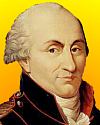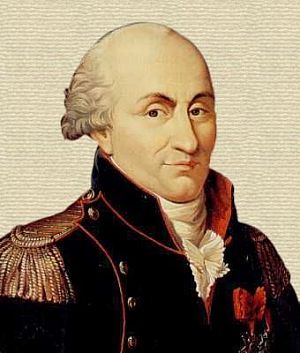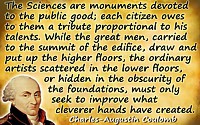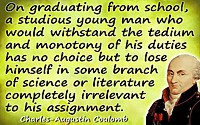 (source)
(source)
|
Charles-Augustin Coulomb
(14 Jun 1736 - 23 Aug 1806)
French physicist who was a civil engineer in his early career, and later conducted experiments on electricity, for which he is best known. The SI unit of charge was named for him.
|
Charles Augustin de Coulomb.
by John Munro
from Pioneers of Electricity; or, Short Lives of the Great Electricians (1890)
[p.79] Coulomb has been regarded as the pioneer of experimental science in France, as William Gilbert was in England. The fame of both rests principally on their electrical and magnetic researches. Gilbert, the physician, who flourished two centuries earlier, obtained results which were chiefly qualitative. Coulomb, the mathematician and engineer, with the love of definition and the habit of measurement, inheriting the advances which had been made meanwhile, arrived at quantitative results. He gauged the forces of attraction and repulsion between electrified bodies or magnetic poles, and formulated the laws which governed them.
Charles Augustin de Coulomb was born at Angoulême, on June 14th, 1736, of a good family belonging to Montpelier, which had furnished members to the provincial parliament. He went to school at Paris, and discovering a bent for mathematics, entered the army as a military engineer. Being drafted to the island of Martinique, in the West Indies, he took part in the erection of Fort Bourbon. But the climate was then fatal; most of his comrades died of fever, and Coulomb, after a stay of three years, returned home with his health permanently injured.
His services in the colony were unrewarded, owing to a change of ministry. He was engaged on military duty at Aix, Rochelle and Cherbourg, but also employed his leisure in original work. In 1773 [p.80] he gained some distinction by a paper on ‘Statical Problems applied to Architecture’ which was presented to the Royal Academy of Sciences, of which he became a corresponding member. Six years later he shared with Van Swinden, the author of Positiones Physicæ, a prize offered by the Academy for the best mode of constructing mariners’ compasses. He was now resident at Rochefort, and in its naval arsenal carried out the experiments on friction and the stiffness of ropes that were published in his memoir on the Theory of Simple Machines, which obtained a double prize of the Academy in 1781. This year he had the good fortune to be established in Paris, and soon improved his position. A scheme for a navigable canal was brought before the States of Brittany, and the Minister of Marine appointed Coulomb to report upon it, as commissary of the king. He condemned the plan as expensive and unprofitable; but it was supported by influential persons, who, in the tyrannous fashion of the time, procured the detention of Coulomb in the prison of the Abbaye, on the frivolous pretext that he had accepted his commission without leave from his superior, the Minister of War. Indignant at this ill-treatment, Coulomb sent in his resignation, but it was not accepted. He was liberated, and then remanded to Brittany, in order to reconsider the project. But his new examination only confirmed his former opinion, which at length began to prevail, and the States, in gratitude for his services, offered him a handsome present; but Coulomb only accepted a seconds’ watch, which was afterwards useful in his experiments.
In 1784 he was made Intendant of the Waters and Fountains in France; and two years later obtained the reversion to the post of Conservator of Plans and [p.81] Reliefs. He rose to be lieutenant-colonel in the engineers, and was nominated a chevalier of St. Louis and a member of the Legion of Honour. About this time, too, he was sent into England by the Academy of Sciences, as one of a commission to study the administration of the hospitals in that country.
In 1784 he presented a paper to the Academy on the elasticity of wires under a twisting stress. While making these experiments he observed that a very feeble force was sufficient to twist a long thin wire through a large angle, and thus was led to invent his well-known torsion balance. It consists essentially of a light index or ‘needle’ suspended by a fine wire, and screened from currents of air by a glass cover. When the needle is deflected from its zero position through a certain angle by a disturbing force, it can be brought back to zero against the force by countertwisting the suspension wire, and the torsion of the wire becomes a measure of the disturbing force. To this end a graduated scale is added, to indicate the turns of the counter-twist. The rate of oscillation of the needle when deflected is also a means of calculating the disturbing force.
The torsion balance has been used for many purposes, notably by Cavendish in determining the density of the earth, by comparison with that of a ball of lead. But it was never applied more successfully than by its inventor. The feeble forces of frictional electricity and magnetism awaited measurement, and Coulomb undertook the work. Gilbert had used a pivoted needle to detect these forces, but not to gauge their intensity. Coulomb’s needle was much more sensitive. He constructed one in which a degree of the scale was equivalent to a force of 1/100000 of a grain weight; and another in which the needle, suspended by a single fibre of silk, was [p.82] deflected through a right angle by a stick of rubbed sealing-wax held at the distance of a yard.
By presenting electrified bodies to the needle, which could itself be electrified, Coulomb discovered that the force of attraction or repulsion between two quantities of electricity was directly proportional to the quantities, and inversely proportional to the square of the distance between them. That is to say, he found that the electrical forces obeyed the same law as the force of gravitation.*. If the distance between the bodies was doubled, or trebled, or quadrupled, the force they exerted on each other was respectively a fourth, a ninth, or a sixteenth of what it had been.
Coulomb also found that electricity parts itself between a number of conductors by contact, and sheds itself over their exterior surfaces, where it resides. So that if a charged conductor were turned outside in, the charge would shift its place to keep on the exterior. Armed with a little insulated carrier of electricity, which he called a ‘proof-plane,’ he tested the distribution of electricity on the surfaces of conductors of different shapes, and found that the density of charge was greatest on sharp points and edges. He also showed that the loss of charge from a conductor increased with the density of the charge and the humidity of the air; discoveries which illustrated the failure of Gilbert’s experiments in moist weather, and Franklin’s observation that pointed conductors are the best dischargers. All these effects Coulomb explained by the tendency of electricity to repel its like.
In the same way Coulomb proved that the force of attraction or repulsion between two magnetic poles is directly proportional to the strength of the poles, or, [p.83] to use a later phrase, the quantity of ideal magnetic matter in the poles, and inversely proportional to the square of the distance between them. He showed that the poles were situated near but not quite at the end of a magnet. He investigated the influence of size and shape on the directive power of magnetic needles, and showed that it was better to attach a set of parallel needles to the compass card than a single one. He devised a novel method of magnetising needles by stroking them from the middle to the ends by two magnets while supported between the poles of two other magnets; and he constructed a very powerful magnetic battery. He adopted the view that every magnet was made up of minute parts, each a tiny magnet, and he demonstrated that iron lost its magnetic virtue when raised to a temperature of 700º Centigrade, that is, when red hot.
These, and more discoveries of the kind, were made between the years 1785 and 1789. They paved the way for the theorems of Poisson and others; and the international congress of electricians at Paris in 1884 have signalised their value by terming the practical unit of electric quantity, a ‘Coulomb.’
At the outbreak of the Revolution, in 1789, Coulomb resigned all his appointments; and, expelled from Paris by the edict which banished the aristocracy, he retired with his friend the Chevalier Borda, to a small estate near Blois. The Royal Academy of Sciences was suppressed, and his name struck out of the Commission on Weights and Measures. After a time, however, he was recalled to Paris by the revolutionary government, to assist in determining the new system of weights and measures which had been decreed. At the desire of his wife, however, he returned again to the country to devote himself to the care of his family. But, on the restoration of the Academy of [p.84] Sciences as the Institute of France, he went again to Paris, and became one of its original members. He was now appointed Inspector-General of Public Instruction, and made a tour in the provinces, where he created a favourable impression by his paternal kindness to the pupils of the schools.
In spite of his ill health, official duties, and vicissitudes of fortune, Coulomb made a considerable number of investigations, chiefly of an engineering nature. At Blois he observed that the sap of poplar trees ascended near the centre of the trunk, and was mixed with air, which could be tapped by a bore-hole. He investigated the friction of pivots; the viscosity of fluids; and the energy of men as affected by food and climate, showing that a labourer in the West Indies only did about half the work of one in France. His last researches were in magnetism. Formerly he had believed that the magnetic property was common to all bodies, in some degree; but just before his death he found reason to modify his opinion, by observing that a grain of iron could communicate a sensible magnetism to 20 lbs. of another substance. A collected edition of his various memoirs was published by the Société Française de Physique of Paris, in 1884.
Coulomb had long suffered from chronic ailments, and being attacked by a slow fever, he died at Paris on August 23rd, 1796.
He was the first to apply mathematics to the phenomena of electricity, and his experimental work was exact as it was profound. Moreover, his moral conduct was as correct as his experimental work. The affair of the canal is a sign of the integrity and independence of his public character. In private life he was an affectionate and prudent husband, happy in the society of his wife and children. His disposition was benevolent and disinterested, without weakness; [p.85] and modest, but not spiritless. Notwithstanding the irritations of ill health acting on a nervous temperament, his manners were gentle, and sometimes mildly gay. Severe with his own, he was nevertheless indulgent to the faults of others; and while his serious character inspired respect, his amiable behaviour made him popular without exciting envy. So little did he care for wealth, that he left his two sons little patrimony except the love and gratitude of his fellow men. Take him for all in all, Coulomb was an honour to his country.
* We give the full expression of the law. Cavendish and others also discerned it.
- Science Quotes by Charles-Augustin Coulomb.
- 14 Jun - short biography, births, deaths and events on date of Coulomb's birth.
- Charles-Augustin Coulomb - context of quote “The sciences are monuments” - Medium image (500 x 350 px)
- Charles-Augustin Coulomb - context of quote “The sciences are monuments” - Large image (800 x 600 px)
- Charles-Augustin Coulomb - context of quote “Withstand the tedium and monotony of his duties” - Medium image (500 x 350 px)
- Charles-Augustin Coulomb - context of quote “Withstand the tedium and monotony of his duties” - Large image (800 x 600 px)
- Coulomb and the Evolution of Physics and Engineering in Eighteenth Century France, by C. Stewart Gilmor. - book suggestion.







